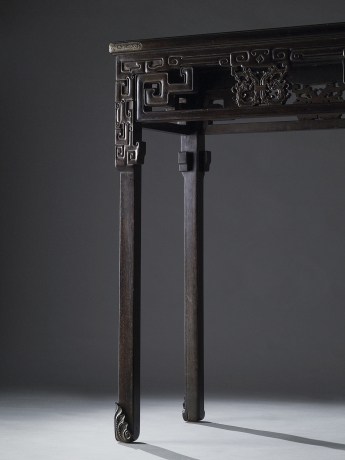Estimate
TWD
11,538,000-15,385,000
HKD
3,000,000-4,000,000
USD
387,100-516,100
Sold Price
TWD
21,230,769
HKD
5,520,000
USD
712,258
In general, despite its delicacy, you can see its great intensity, as long as life itself, of an exquisite unique design, which makes it a beautiful and exclusive piece of furniture, a shining example of the exquisiteness of the Qing dynasty. Since the establishment of the Ming dynasty in the mid 14th century, by the beginning of the 15th century (corresponding to the year 1405, the third year of the reign of the emperor Yongle), Zheng He had already made seven journeys on diplomatic missions on the Western seas. For over twenty years he had been the pioneer in long-distance sea travel and has gone down in history for having been the first to sail such long distances. It was in that period when China’s contacts with Southeast Asia and India began and intense trading relations were established. From then on, China imported and used large quantities of the high-quality hardwood produced in the tropical areas of Southeast Asia, such as zitan wood, rosewood, etc. These valuable woods, stable in colour and with an elegant fine grain, had been produced for centuries and became scarce.
Precise, firm, solid notches and pegs were made with the plane, most suitable for carving, making them the best possible choice for furniture making. In that period the regions of Guangdong, Yangzhou, Suzhou and Peking were the most renowned furniture-making centers in China and they made great use of these valuable materials, which were the best and highest quality in furniture making in the country. Gradually, these excellent-quality imported woods, along with internal elements, caused the rigid structure of the furniture and the technical prowess of the Ming dynasty carpenters to develop. Their external appearance was also more in line with customers’ tastes for furniture made of woods of brilliant stable colours and the varied and beautiful types of wood grain. During the first years of the Qing dynasty, the lacquered and huang huali furniture of the Ming dynasty, simple but elegant, was gradually replaced by the zitan wood furniture of great quality and sumptuous style, achieved by carving, incrustations, line drawing and painting. Also, styles were assimilated from many foreign cultures, so that Chinese furniture was continually being renewed. Since then, exquisite, valuable zitan wood furniture had already become a byword for the best quality furniture of the court of the Qing dynasty.












